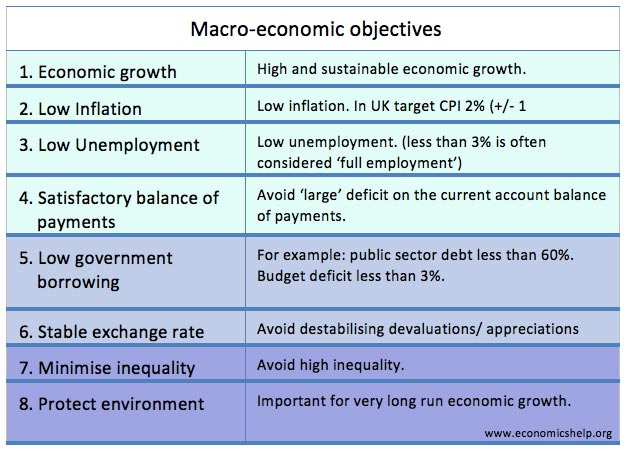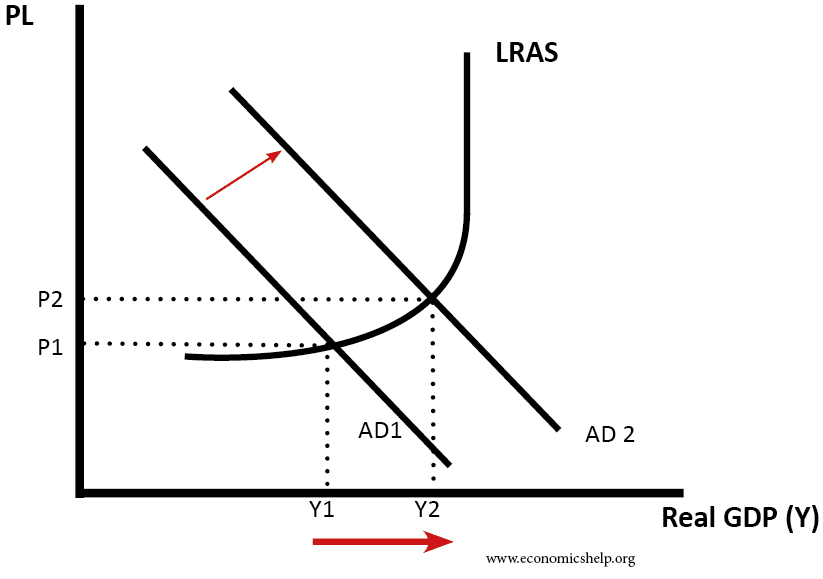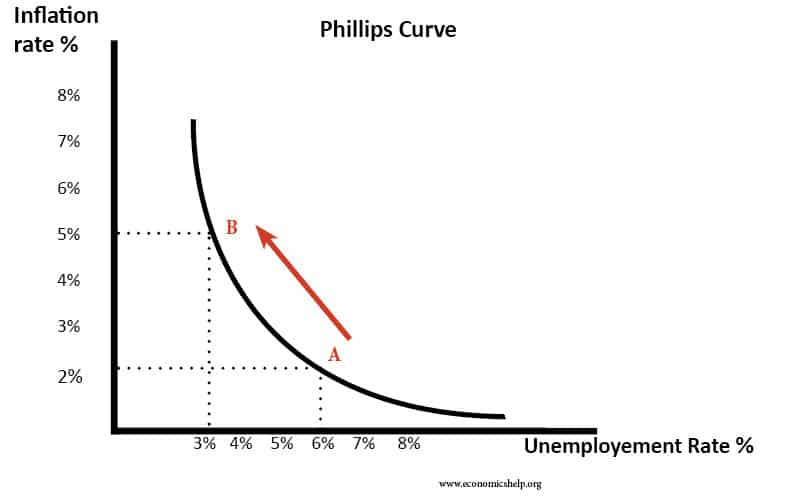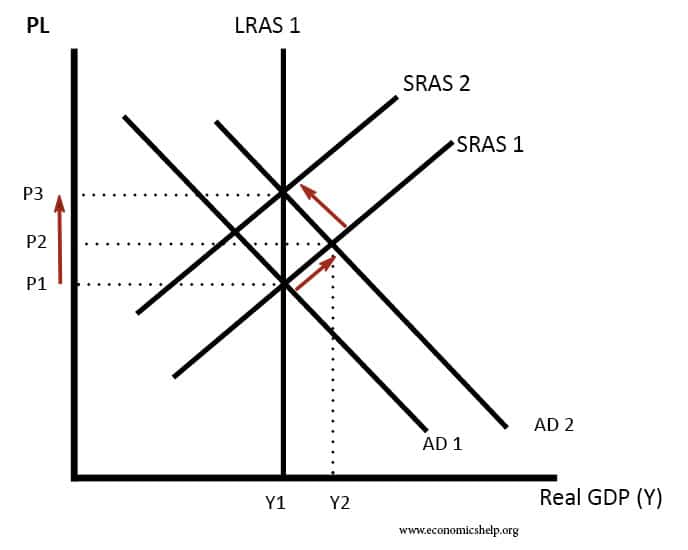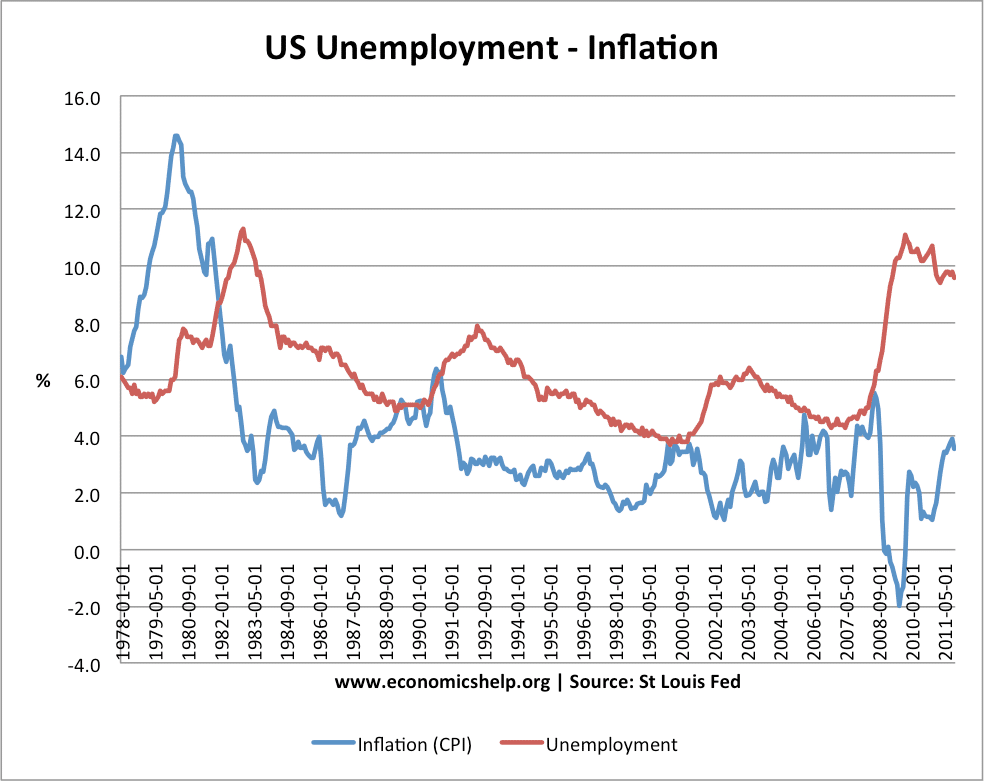The main macroeconomic objectives of the government will include: low inflation, increasing the sustainable rate of economic growth full employment and balance of payments equilibrium.
Full employment involves zero or very low unemployment. In practice, there will always be some frictional unemployment as people are looking for new jobs or leaving school. Economists suggest an unemployment rate of 3% is close to full employment. However, it is difficult to determine precisely. Full employment implies the macroeconomy is operating at its full capacity and there is no output gap or demand deficient unemployment.
The main reason for targeting full employment is because high unemployment has various social and economic costs. Firstly, the unemployed will have low income enabling low levels consumption. This low income will lead to relative poverty. Also, the unemployed may become de-motivated and de-skilled. On the job training, is considered important to employers. Being unemployed with no money to spend on training and unable to work can create a negative cycle for the unemployed which makes it difficult for them to find work in the future. People experiencing long-term unemployment find it the most difficult to gain employment. (Hysteresis effect)
Also, during periods of high unemployment, the government will have to spend more on unemployment benefits and also the government will receive lower tax revenues (less VAT, lower income tax). Therefore, high unemployment will increase government borrowing. Finally, unemployment may exacerbate social problems such as crime, vandalism and social alienation, especially if unemployment is concentrated amongst young people who feel alienated by having no jobs.
Therefore, given the costs of unemployment, there are many social benefits to achieving full employment. Also, by achieving full employment, it will have the side-effect of improving other objectives of the government. Lower unemployment will reduce government borrowing and help economic growth. If the unemployed gain work, they will increase spending, and this will cause a positive multiplier effect which helps to increase economic growth.
Achieving full employment
To achieve full employment, if there is a negative output gap, Keynesians will argue that it is necessary to increase AD.
This can be achieved by loose fiscal or monetary policy e.g. lower interest rates. Increasing AD may cause inflation to increase, but if there is spare capacity there should only be a limited increase in inflation. Therefore, there is a strong case for aiming for full employment through demand management (either fiscal or monetary policy)
The Phillips curve suggests there is a trade-off between inflation. Therefore, achieving full employment may cause a side effect of inflation.
Not all economists agree that full employment should be the primary objective They argue that unemployment cannot be reduced below the natural rate of unemployment without causing inflation. Also, any reduction in unemployment below the natural rate, due to demand-side policies, will be just a temporary. This is because the economy will return to the equilibrium level of output.
In the Monetarist model, an increase in AD causes higher real GDP (Y1 to Y2) but this increase in real GDP is only temporary.
Monetarists believe there is no point in reducing unemployment below the natural rate because the only effect will be to increase inflation. Therefore, according to Monetarists attempts to achieve ‘full employment’ of 3% may conflict with other macroeconomic objectives, such as higher inflation.
Many Western economies have an inflation target as the primary objective of their Central Bank. (e.g. ECB inflation target = 2%) The argument is that if low inflation is achieved, it will enable economic stability and encourage investment and sustainable growth in the long term. This is preferable to a government using demand-side policies and causing boom and bust cycles.
However, other economists dispute the fact there has to be a trade-off between unemployment and inflation. Low unemployment can also be achieved through keeping inflation low and maintaining steady and sustainable growth. For example, in the 1990s, both unemployment and inflation fell due to supply-side policies and effective demand management by the MPC. Therefore, this suggests that a low inflation target can be effective in meeting other objectives as well. This period of low unemployment and low inflation ended with the credit crunch of 2008, and also a period of cost-push inflation.
Achieving full employment with supply side-policies
Another way of aiming for full employment is to use supply-side policies to try and reduce the natural rate of unemployment. For example, better education can improve the skills of workers and therefore reduce structural unemployment. Also, the government may need to pursue free-market supply-side policies – increasing labour market flexibility and reducing barriers to employing workers. However, there is no guarantee supply-side policies will be effective. Increased labour market flexibility could lead to job insecurity and a rise in part-time temporary employment.
Overall low unemployment is a desirable objective, but the policies to achieve this need careful examination. Increasing AD will only be effective if there is a recession and spare capacity. To reduce the natural rate of unemployment, effective supply-side policies will be needed.
Great recession and criticism of ECB
During the great recession of 2008-13, it is a valid criticism that Central Banks like the ECB, placed too little emphasis on reducing unemployment in Europe. They placed too much emphasis on low inflation and deficit reduction, ignoring the much bigger social problem of unemployment.
Readers Question: What are the positive and negative effects of full employment?
Positive effects
- Maximising potential output in an economy, achieving productive efficiency and economic growth
- Reduces inequality and prevents relative poverty from those who are unemployed.
- Full employment will improve business and consumer confidence which will encourage higher growth in the long-term.
- Unemployment is a big cause of poverty, stress and social problems.
- Full employment reduces government welfare spending and enables more income taxes – improving budget position
Negative effects
- Full employment may cause labour shortages and wage inflation. This can lead to ordinary inflation.
- Attempting to achieve full employment could lead to a boom and bust economic cycle. If growth is above the long run trend rate, the growth will be unsustainable.
- Britain’s period of full employment in the 1950s meant many companies struggled to fill vacancies in unpopular jobs; this labour shortage was partly solved by encouraging immigration.
Evaluation
Full employment doesn’t necessarily have to be inflationary. If the growth is sustainable, we could get close to full employment without inflationary pressures. It depends on the skills of the workforce. If there are big labour shortages in skilled labour, full employment could lead to shortages of labour.

